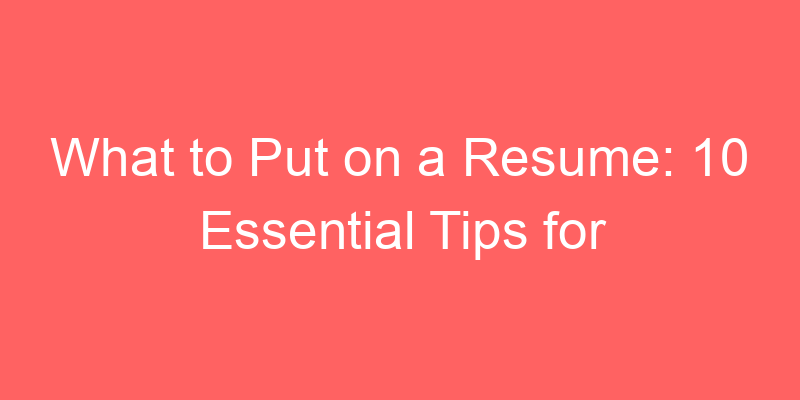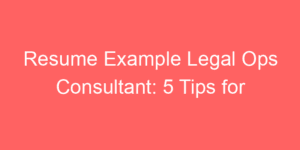Essential Elements to Include on a Resume
Creating a compelling resume is essential for effectively showcasing your skills and experiences to potential employers. Here are the key elements you should include on your resume:
Contact Information
At the top of your resume, include your full name, phone number, email address, and LinkedIn profile (if applicable). Make sure your contact information is up-to-date and professional.
Professional Summary
Write a brief summary highlighting your key skills, experiences, and career objectives. This section should provide a snapshot of who you are as a professional and what you bring to the table.
Work Experience
Detail your work history in reverse chronological order, starting with your most recent job. Include job titles, company names, dates of employment, and key responsibilities and achievements for each role.
Education
List your educational background, including degrees, certifications, and any relevant coursework or honors. Include the name of the institution, degree earned, and graduation date.
Skills
Highlight your technical and soft skills relevant to the job you’re applying for. Be specific and provide examples of how you’ve used these skills in previous roles.
Achievements
Include any notable achievements or awards that demonstrate your capabilities and accomplishments. This could include exceeding sales targets, receiving recognition for outstanding performance, or completing significant projects.
Additional Sections (Optional)
You may also choose to include additional sections such as:
- Volunteer Experience: Highlight any volunteer work or community involvement that demonstrates your character and commitment.
- Licenses and Certifications: List any professional licenses or certifications relevant to your field.
- Languages: If you’re proficient in multiple languages, mention them on your resume.
- Professional Memberships: Include any memberships in professional organizations or associations.
Conclusion
Putting together a strong resume requires careful consideration of the essential elements that effectively showcase your qualifications and experiences. By including contact information, a professional summary, work experience, education, skills, achievements, and optionally, additional sections, you can create a comprehensive document that captures the attention of potential employers and helps you stand out in the job market.
Tips for What to Put on a Resume
Creating a compelling resume is a crucial step in your job search journey. Knowing what to include on your resume can significantly impact your chances of landing interviews and ultimately securing your desired position. In this guide, we’ll explore essential tips for crafting a standout resume that effectively showcases your qualifications and experiences.
Career Advice and Tips
1. Tailor Your Resume to the Job Description
One of the most important tips for resume writing is to customize your resume for each job application. Carefully review the job description and highlight the skills, experiences, and keywords that match those requirements. Tailoring your resume shows employers that you’re a good fit for the role and increases your chances of getting noticed.
2. Highlight Your Achievements
Instead of simply listing job duties, focus on quantifiable achievements and contributions. Use metrics and numbers to demonstrate your impact in previous roles. Whether it’s exceeding sales targets, improving efficiency, or leading successful projects, highlighting your achievements helps employers understand the value you can bring to their organization.
3. Include Relevant Keywords
Many employers use applicant tracking systems (ATS) to screen resumes before they reach human eyes. To ensure your resume makes it past the initial screening, incorporate relevant keywords related to the job and industry. These keywords can include specific skills, certifications, software programs, and industry buzzwords.
4. Provide a Professional Summary or Objective
A professional summary or objective at the beginning of your resume can provide a snapshot of your qualifications and career goals. Use this section to briefly highlight your key skills, experiences, and what you bring to the table. Tailor your summary to the specific job you’re applying for and focus on how you can add value to the employer.
10 Similar Jobs Related to What to Put on a Resume
| Job Title | Description |
|---|---|
| Content Writer | Creates engaging written content for websites, blogs, and marketing materials. |
| Graphic Designer | Designs visual concepts using computer software to communicate ideas that inspire, inform, or captivate consumers. |
| Marketing Coordinator | Assists with the implementation of marketing strategies and campaigns to promote products or services. |
| Human Resources Assistant | Provides administrative support to the HR department, including recruiting, onboarding, and employee relations. |
| Project Manager | Oversees the planning, execution, and completion of projects within specific timeframes and budgets. |
| Customer Service Representative | Handles inquiries and resolves customer issues or complaints, ensuring a positive customer experience. |
| Software Developer | Designs, develops, and maintains software applications to meet user needs. |
| Financial Analyst | Analyzes financial data and provides insights to support decision-making within organizations. |
| Executive Assistant | Provides administrative support to high-level executives, including scheduling, travel arrangements, and correspondence. |
| Social Media Manager | Develops and implements social media strategies to increase brand awareness and engage audiences. |
Career Path Visualization for Professionals Focusing on Resume Content
| Entry-Level | Mid-Level | Senior-Level | Executive-Level |
|---|---|---|---|
| Intern | Marketing Coordinator | Marketing Manager | Chief Marketing Officer (CMO) |
| Customer Service Representative | Customer Service Manager | Director of Customer Experience | Chief Customer Officer (CCO) |
| Administrative Assistant | Executive Assistant | Office Manager | Chief Administrative Officer (CAO) |
Example: Applying These Tips in Practice
Let’s consider an example of applying these resume tips. Sarah, a marketing professional, revamped her resume by tailoring it to the job description for a Marketing Manager position. She highlighted her achievements, including increasing social media engagement by 50% and launching successful email marketing campaigns. By incorporating relevant keywords and providing a professional summary that emphasized her leadership skills, Sarah’s resume stood out to recruiters, leading to multiple interview opportunities.
Remember, your resume is your personal marketing tool, so make sure it effectively communicates your value to potential employers.
Generate Your NEXT Resume with AI
Accelerate your resume crafting with the AI Resume Builder. Create personalized resume summaries in seconds.




